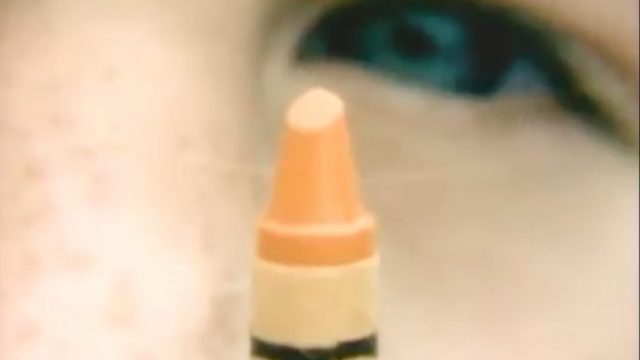“How Crayons are Made” (1981) dir. Unknown
Only 80s kids understand you can’t explain the industrial process that produces crayons without holding a tangerine Crayola uncomfortably close to your eye.
Educational films have a frequently deserved reputation as dry, square and/or unintentionally funny, but PBS’s longtime children’s program Sesame Street produced shorts that taught in the conventional sense while also making imaginative and entertaining connections. Frequently, when not focusing on basic alphabet and number skills, the segments acted as a window between the world of the child and the mysterious working world that Mom and/or Dad and the other grownups seemed to know and navigate so well.
“How Crayons are Made” was produced for PBS’s Sesame Street (episode 1590, airdate December 11, 1981 to be exact) and was included several episodes during the show’s run, becoming a striking fixture in the show for at least a decade. The bright orange is a particularly memorable choice, making the paraffin and pigment pop in the midst of an otherwise drab industrial floor. This contrast between the vivid material and the gray world around it mimics the young viewer’s ability to discern the wonder in a job adults consider menial. The idea that people and machines make crayons by the thousands – and a machine shoves them into the boxes! – fires the young imagination, even if a couple facial expressions suggest that the thrill has worn away for some of these factory workers. We’re learning more than the answer to a question about the origin of crayons. We’re connecting the question to the larger idea that things in the world are created, and the process of creation can mean factories and factory workers, (and later truck drivers and retailers glimpsed in other Sesame Street shorts).
From the earliest days Sesame Street made explicit connections between play and career.
“Body Parts vs. Heavy Equipment” (1969) dir. Jim Henson
“Body Parts vs. Heavy Equipment” aired in the third episode of the series (November 12, 1969). This, the first live-action segment produced for Sesame Street not featuring Muppets, builds from an idea first demonstrated by Jim Henson in a similar short called “Wheels That Go” (1967 – available to FilmStruck subscribers). Henson’s contributions are mostly remembered in the Muppet and animated segments, but his influence in the live shorts were important as well. The idea of crosscutting between children at play and the job they’re playacting would recur in other Sesame Street vignettes, sometimes to the point of remake (like an early 70s segment where children play in the sand at a beach).
A happy byproduct of this method of teaching is a basic cinematic language education. An Eisensteinian cut between the motions of the kids and the construction equipment they’re imitating makes the comparison clear to young viewers in the same way the dissolve between the crayon closeup and the vat of orange liquid makes a flashback easy to follow.
Both of these shorts exemplify Sesame Street, a show where the time has not yet come to put away childish things, but to see how we will carry those things into the future. Without putting too sharpened a point on it, it’s interesting to note the decline of manufacturing in the United States and the rise of children’s programming more concerned with granting powers to heroes and princesses than discovering where our playthings are made.
- Special mention must be made about the two music tracks used in the first segment, both by Richard Harvey.
- One of the boys in the second segment is Brian Henson, Jim’s son. In the behind-the-scenes book Street Gang, Brian describes that day working for his father who, true to form, taught him to take the job seriously. He was rewarded with a paycheck of his own for his time.

